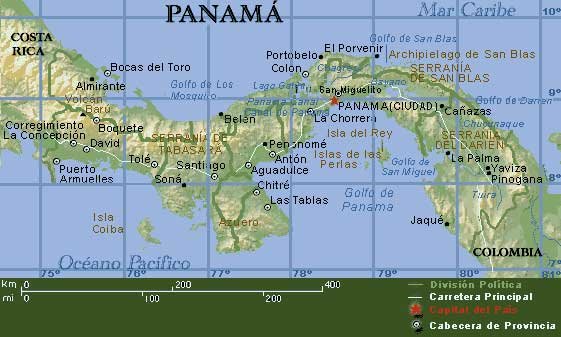As in most housing decisions, location, location, location. When we were living with host families over a year ago and trying to select a house to move into on our own, one of our biggest considerations was water: both having a year-round supply from the aqueduct and not having water in the house due to leaks or overflowing creeks (a problem we saw in one or two possibilities). The island has several communities served by five or six main systems and a couple of small ones, all gravity fed. Last summer, along with the new sidewalk, money from the canal paid for improvements to three of the aqueduct systems.
The house we picked is located just below the tank for the northern half of our community.

(From our yard up the hill to the tank, the white thing on the hill toward the right)
Our tank is on a hill about a four minute climb from our house, probably 75 to 100 feet in elevation.

(From the top of the tank looking down toward our house, on the right of the field)
A two-inch diameter PVC line runs out of the tank, down the hill, through a chlorine filter (still without chlorine, since the Ministry of Health (SALUD) has not yet come to give a charla on how to use the filter), and then parallels the path (now sidewalk) toward the school. Originally we thought it went all the way to the school (and had to climb the hill to the school, hence the school, and the houses nearby, was occasionally without water), but recently someone told me that with the changes last summer, it now only serves eight occupied houses. (Between that eighth house and the next one towards the school there is a five minute uninhabited stretch, and there is another tank above that next house, which feeds from there to the school.)
All the houses “T” off of the mainline. There is a On/Off on the mainline coming out of the tank, but none beyond that; if anyone wants to do work on their line or add a new one, everyone has to lose water (when we put in our system, we included a switch by the house so we could at least turn off the water if we wanted to work on any of our faucets).
The tank is a cinderblock box with a two-inch diameter PVC pipe input line dropping water in from high on one side, the outflow line feeding out the bottom, and an overflow pipe for when the users are not taking water faster than the input.

(The tank, with ladder, a nice addition from the older version, and the overflow pipe showing that we are getting more than enough water into the tank, right now at least)
The tank is filled by the input line coming down through the woods and fields of our neighbor from a caja de agua (water box) about ten minutes hike from the tank. The caja is merely a small dam across the small creek that eventually goes behind our house. The caja was also cleaned out with last year’s improvements, as sediment had filled in the old “lake”.

(The input line typically runs underground, but it does go over one creek, propped and tied with an old extension cord)

(The view of the front of the dam for the caja)
There is a box on the upstream side of the dam that admits water through a screen (I think) at the bottom sides of the box, which then filters through small rocks and out the feeder pipe to the tank. The sides of the box were raised above the level of the dam with last year’s improvements, to decrease the amount of debris getting into the box when heavy rains caused the creek to rise.

(Water enters the box through two screens on the sides then filters through small rocks into the feeder pipe to the tank)
Sometime soon, there should be a junta (work group) to clean the tank: scrubbing the walls on the inside and rinsing it. It will be just the second or third cleaning I know of since we got here. Supposedly they will be starting an aqueduct committee soon to collect a monthly user fee of probably 25cents or so to pay for occasional maintenance and repairs. But mostly the system runs on gravity, without moving parts, and as long as the pressure is sufficient, everyone has water; we’re at the lowest point on the line, and just below the tank, so we’ve only been low once or twice, which is luckier than many of our neighbors and it sounds like many of our fellow PCVs.
So that is how simple our water system is; I can hike from my house to the source in about fifteen minutes. (A couple of months ago, I went all the way up the creeks to see if there was a need for reforestation near the stream – there wasn’t – but those pictures were with the camera when it was stolen.)
PS: There are also pretty little brilliant blue crawdads in the small pond above the dam.




1 comment:
Nice explanation of your very simple water supply and distribution system. The photos are worth a trillion words, good work. My only questions are how often or if the system is ever wiped out by storms? And do you boil or treat your house supply before drinking? Maybe the PC can help install isolation valves at each house.
Post a Comment